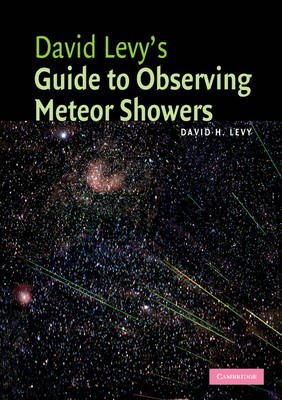
David Levy's Guide to Observing Meteor Showers
Cambridge University Press (Verlag)
978-0-521-69691-3 (ISBN)
- Titel ist leider vergriffen;
keine Neuauflage - Artikel merken
Meteors occur when a meteoroid, a speck of dust in space, enters the Earth's atmosphere. The heat generated when this happens causes the surrounding air to glow, resulting in 'shooting stars'. During the most spectacular meteor storms larger particles give rise to fireballs and firework-like displays! Meteors are a delightful observing field - they do not require a telescope, and they can be seen on any clear night of the year, even in bright twilight. It was the sight of a single meteor that inspired David Levy to go into astronomy, and in this book he encourages readers to go outside and witness these wonderful events for themselves. This book is a step-by-step guide to observing meteors and meteor showers. Any necessary science is explained simply and in clearly understandable terms. This is a perfect introduction to observing meteors, and is ideal for both seasoned and budding astronomers.
David H. Levy is one of the most successful comet discoverers in history. He has discovered 22 comets, nine of them using his own backyard telescopes. Together with Eugene and Carolyn Shoemaker at the Palomar Observatory in California he discovered Shoemaker-Levy 9, the comet that collided with Jupiter in 1994 producing the most spectacular explosions ever witnessed in the solar system. He is involved with the Jarnac Comet Survey, and Science Editor for Parade magazine, and contributing editor for Sky and Telescope. He has been awarded five honorary doctorates, and asteroid 3673 (Levy) was named in his honor. His other recent books include David Levy's Guide to Observing and Discovering Comets and David Levy's Guide to Variable Stars (Cambridge University Press).
Preface; 1. July 4, 1956; 2. What is a meteor?; 3. Some historical notes; 4. Small rocks and dust in space; 5. Observing meteors; 6. Recording meteors; 7. Quadrantids; 8. Lyrids; 9. The Eta Aquarids; 10. The Omicron Draconids; 11. Delta Aquarids; 12. Perseids; 13. The Gamma Pavonids; 14. Orionids; 15. Taurids; 16. Leonids; 17. Geminids; 18. Ursids; 19. Meteor showers throughout the year; Appendix.
| Erscheint lt. Verlag | 29.11.2007 |
|---|---|
| Zusatzinfo | 28 Halftones, unspecified |
| Verlagsort | Cambridge |
| Sprache | englisch |
| Maße | 172 x 246 mm |
| Gewicht | 298 g |
| Themenwelt | Sachbuch/Ratgeber ► Natur / Technik ► Weltraum / Astronomie |
| Naturwissenschaften ► Physik / Astronomie ► Astronomie / Astrophysik | |
| ISBN-10 | 0-521-69691-7 / 0521696917 |
| ISBN-13 | 978-0-521-69691-3 / 9780521696913 |
| Zustand | Neuware |
| Haben Sie eine Frage zum Produkt? |
aus dem Bereich


